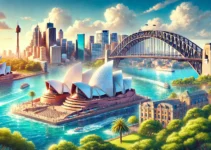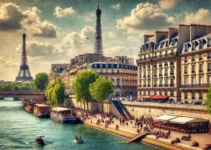I’m excited to show you the beauty of Iceland’s Natural Wonders. This island is full of natural wonders, from geothermal spots to stunning landscapes. It’s small, making it easy to see many sights in a short time.
Iceland’s glaciers cover about 11% of the land. These huge ice formations are just one of the many wonders here. You’ll find over 1600 waterfalls, each over 2 meters tall. Don’t miss the breathtaking Goðafoss, Gullfoss, and Seljalandsfoss.
What’s amazing about Iceland is its geothermal power. This natural heat is used to generate most of the country’s energy. The Blue Lagoon, a geothermal spa, is one of the 25 Wonders of the World by National Geographic. Soaking in its warm, mineral-rich waters is unforgettable.
Getting to Iceland is easy from Europe and North America. It’s perfect for family trips or road adventures. From May to August, you can see the Midnight Sun, with 24 hours of daylight.
Key Takeaways
- Iceland’s compact size allows for diverse sightseeing in a short time
- Over 1600 waterfalls higher than 2 meters dot the landscape
- Geothermal power provides most of Iceland’s energy
- The Blue Lagoon is recognized as a world wonder
- Midnight Sun offers 24-hour daylight from May to August
- Iceland is easily accessible from Europe and North America
Introduction to Iceland’s Unique Landscape
Iceland’s landscape is a breathtaking mix of natural wonders. Exploring this island, I’m amazed by its diverse geological features. Glaciers, icebergs, and volcanic landscapes make it a feast for the eyes of nature lovers.
The Land of Fire and Ice
Iceland is truly the “Land of Fire and Ice.” With over 10% of its land covered in glaciers and recent volcanic eruptions, like Fagradalsfjall in 2021, the contrast is striking. I’m amazed by how these forces shape the land, making it dynamic and always changing.
Geological Significance
The geological importance of Iceland is incredible. It’s a young land, formed just 16 million years ago. Being above the Mid-Atlantic Rift, I can see the Earth’s crust forming before my eyes. At Þingvellir National Park, I can stand between two moving tectonic plates!
Accessibility of Natural Attractions
What’s amazing is how easy it is to get to these natural wonders. Many attractions are close to the Ring Road. With a small population of over 300,000, most living in one area, there’s a lot of untouched nature to explore. Hiking trails let me see up close the stunning volcanic landscapes.
“Iceland is a living, breathing testament to the power of nature, where fire and ice dance in an eternal embrace.”
The Golden Circle’s 300-kilometer loop and the Vatnajökull ice caves are just the start. Iceland’s size lets me see many natural wonders in a short time. It’s a paradise for those who love nature and adventure.
The Mesmerizing Northern Lights
I’ve always dreamed of seeing the Aurora Borealis, and Iceland is the perfect place for it. From September to April, the night sky lights up with dancing lights. These lights paint the sky in green, pink, and violet.
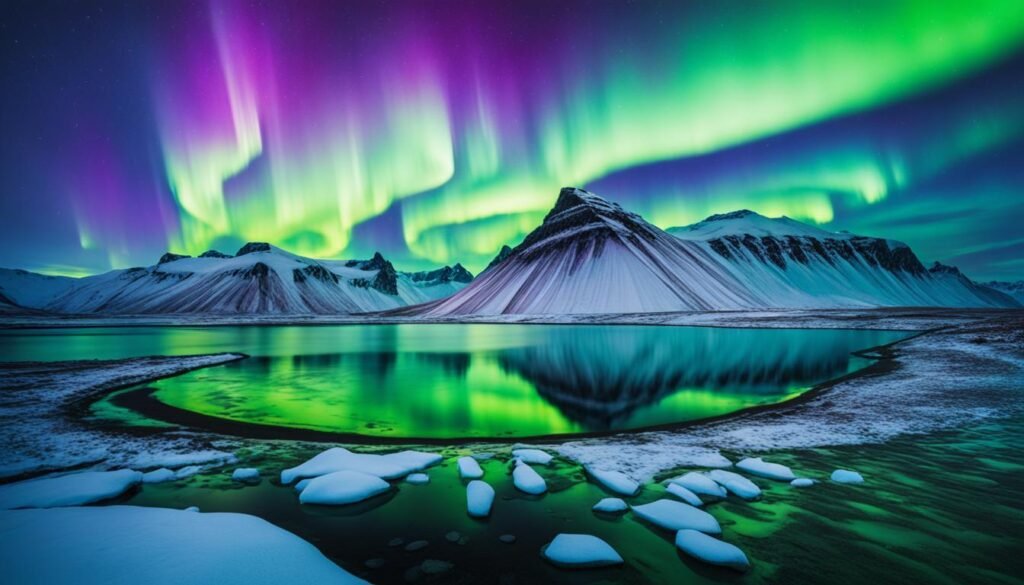
The northern lights are a natural wonder that amazes everyone. Iceland is great for seeing them because it’s at 64 degrees north. This means you have a good chance of seeing the lights since it’s dark for up to 20 hours in winter.
For the best view, go to the Westfjords or North Iceland. These places have more darkness and fewer clouds. South Iceland, near Jokulsarlon glacier lagoon, also has beautiful views for taking pictures of the northern lights.
“Witnessing the Aurora Borealis dance across the Icelandic sky is a life-changing experience that leaves you in awe of nature’s magic.”
To see the lights, check the aurora forecast. If it’s over a 3 on the 1-9 scale, go out. Plan your trip between late August and for the best chance to see this amazing sight.
| Viewing Method | Pros | Cons |
|---|---|---|
| Town-based | Convenient, no extra travel | Light pollution may affect visibility |
| Guided tour | Expert knowledge, higher chances | Less flexibility, higher cost |
| Self-drive | Freedom to explore, privacy | Requires navigation skills, weather awareness |
| Boat tour | Unique view, away from light pollution | Weather-dependent, potential seasickness |
While looking for the northern lights, you might see Iceland’s unique wildlife. Arctic foxes and reindeer roam under the stars. Seeing the Northern Lights in Iceland is an amazing adventure. It combines the beauty of the sky with Iceland’s stunning landscapes.
Glaciers and Ice Caves: A Winter Wonderland
Iceland’s glaciers and ice caves are a breathtaking sight. Over 11% of the country is covered by huge ice sheets. The biggest glacier, Vatnajökull, takes up 8% of Iceland and has about 30 outlet glaciers.
Europe’s Largest Ice Cap
Vatnajökull is the biggest ice cap in Europe. It has many glacier tongues and ice caves. The Langjökull Glacier, the second-biggest, has natural and man-made ice caves open all year.
These glaciers are not just beautiful. They also show us the effects of climate change.
Crystal Blue Ice Caves
The Blue Ice Caves of Vatnajökull National Park are a sight to see. They’re open from mid-October to March, showing off electric blue colors. This blue color comes from the ice absorbing all colors but blue.
Some caves can also show white, turquoise, grey, brown, or black colors. This depends on different factors.
Glacier Activities and Tours
People love hiking on glacier trails and going on ice cave tours. Tours usually start in November, using big glacier trucks. It’s important to go with a guide because these places change a lot and can be risky.
Whether you’re in natural caves or man-made tunnels, Iceland’s glaciers are unforgettable. They’re part of the country’s amazing geothermal attractions.
Waterfalls of Iceland: Nature’s Power on Display
Iceland’s landscape is filled with stunning waterfalls, each with its own story. As I explored, I saw how water and rock work together in harmony.
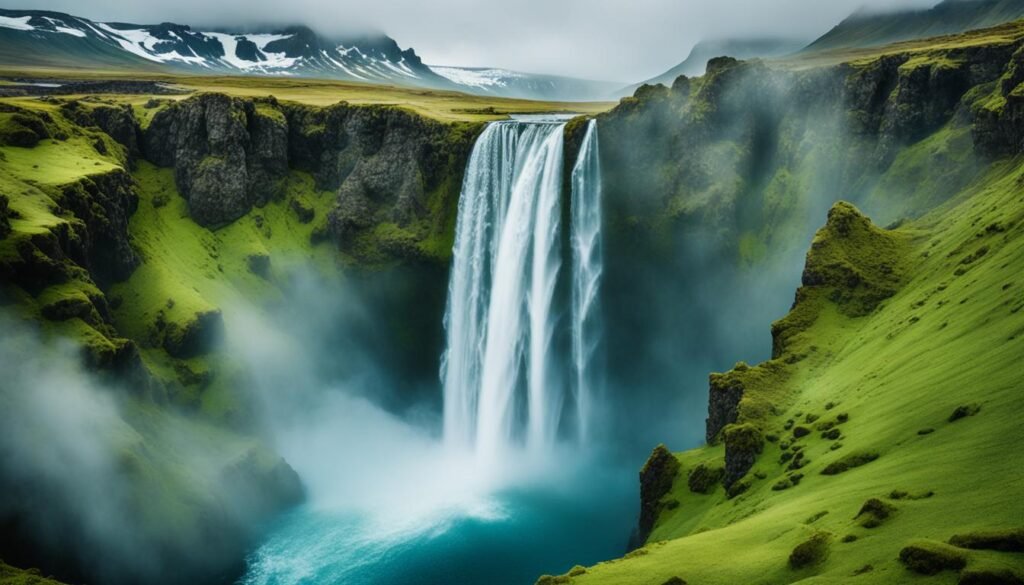
The waterfalls in Iceland are truly amazing. Skogafoss stands tall at 60 meters, with a powerful roar and mist that fills the air. Nearby, Seljalandsfoss lets you walk behind its waters, giving a special view of the land.
Dettifoss is Europe’s most powerful waterfall, showing off nature’s strength. Gullfoss, known as the “Golden Falls,” has two levels where the Hvita River falls, creating a stunning sight.
Hiking trails let adventurers get close to these waterfalls. The path to Hengifoss shows the geological history of the cliffs. Bruarfoss Waterfall has blue waters, perfect for photographers.
“Take your time to appreciate the beauty of each waterfall rather than rushing through all in a single day.”
Summer, from June to August, is the best time to see the waterfalls. Most are free to visit, but some may charge for parking. As I traveled, each waterfall showed me its unique magic, making me stop and admire Iceland’s beauty.
Geothermal Wonders: Hot Springs and Geysers
Iceland’s geothermal attractions are truly amazing. The bubbling hot springs and powerful geysers are a sight to see. They let us peek into the Earth’s fiery core.

The Great Geysir and Strokkur
The Great Geysir in Haukadalur Valley is famous for all geysers. Though it’s quiet now, Strokkur nearby is a showstopper. It shoots water up to 20 meters high every 4-8 minutes. It’s a sight that always leaves me in awe.
Geothermal Bathing Experiences
Geothermal bathing is a big part of Icelandic life. The Blue Lagoon is a must-see, with its blue waters full of silica minerals. For those on a budget, Myvatn Nature Baths in northern Iceland are great. They have thermal waters, nice facilities, and a café.
Harnessing Geothermal Energy
Iceland uses geothermal energy in a smart way. They use it for power and heating. This is a green choice that fits with Iceland’s goal of protecting the environment.
| Hot Spring | Location | Unique Feature |
|---|---|---|
| Blue Lagoon | Southwestern Iceland | Rich in silica minerals |
| Myvatn Nature Baths | Northern Iceland | Affordable alternative to Blue Lagoon |
| Seljavallalaug | South Coast | Man-made pool from 1923 |
| Kvika Foot Bath | Reykjavik | Views of Grotta lighthouse |
From Strokkur’s big eruptions to the Blue Lagoon’s calming waters, Iceland’s geothermal sights are amazing. These natural wonders give us a peek into the country’s geology. They also offer memorable experiences for visitors.
Volcanic Landscapes and Lava Fields
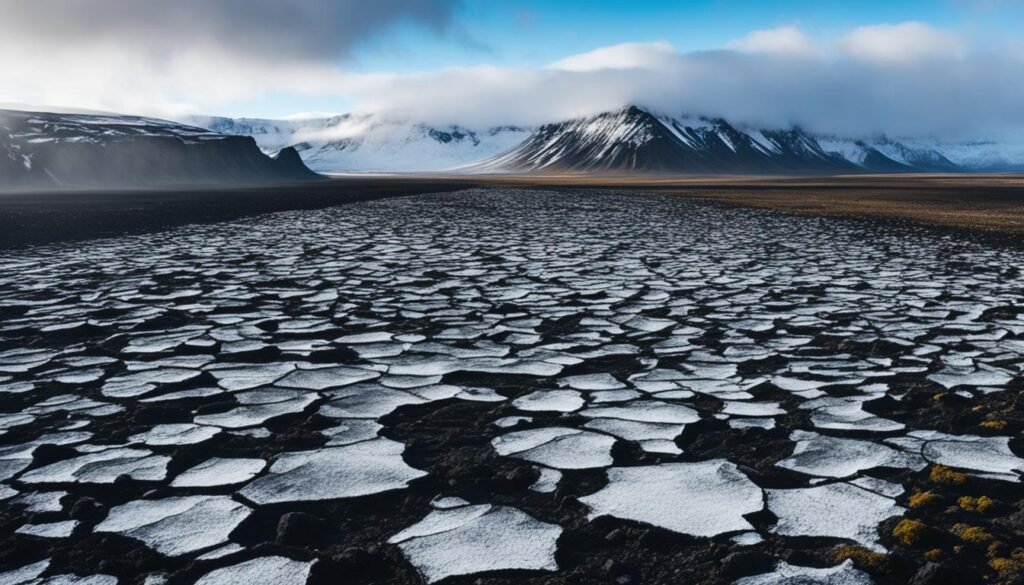
I’ve always been drawn to Iceland’s volcanic landscapes. The country sits right on the Mid-Atlantic Ridge, where fire and ice meet. With 32 active volcanoes, eruptions happen almost every 4-5 years, changing the scenery constantly.
The Reykjanes peninsula is a new addition to Iceland’s volcanic features. It was quiet for 800 years before waking up in 2021. Now, it attracts many who want to see nature’s power up close.
The Eldhraun lava field shows Iceland’s volcanic power. It covers 565 square kilometers, making it one of the biggest lava fields globally. Hiking through it, I’m amazed by the scale of past eruptions.
For a deeper look at Iceland’s volcanoes, visit the Lava Centre museum. It opened in 2017 and shows millions of years of volcanic history. It’s a great place to learn before seeing the volcanoes up close.
“Iceland is a living laboratory of geological processes, where you can witness the Earth’s inner workings on display.”
The Hverfjall tephra crater in North Iceland is stunning. It’s a huge 1 kilometer wide, one of Europe’s biggest. From its rim, I felt like I was looking into the Earth’s core. Nearby, the Krafla caldera stretches 10 kilometers, showing Iceland’s explosive history.
Hiking trails let you see up close the fresh lava flows, strange rock formations, and steaming vents. Each step takes you through time, showing how Iceland was made.
Iceberg Lagoons and Diamond Beach
I’m thrilled to share my visit to Iceland’s stunning iceberg lagoons and Diamond Beach. These places show off the country’s beautiful glaciers and icebergs. They give us a peek into Iceland’s unique landscape.
Jökulsárlón Glacier Lagoon
Jökulsárlón, Iceland’s biggest glacial lagoon, is truly amazing. It started in 1935 and has grown to 18 km2 because of melting glaciers. The lagoon’s blue waters are full of huge icebergs, some as old as 1,000 years.
Only a small part of these ice giants are above water. This adds mystery to the view.
Diamond Beach: Nature’s Ice Sculptures
Close to Jökulsárlón is Diamond Beach, or Breiðamerkursandur. Here, icebergs come ashore and the Atlantic waves polish them into “ice diamonds” on black sand. This creates a perfect scene for photographers, drawing artists from all over the world.
Boat Tours and Photography Opportunities
To see these icy wonders up close, I went on a boat tour in Jökulsárlón. You can choose from amphibious boats, Zodiac tours, or hovercrafts. These tours give you great photo chances and let you see seals and other marine life. Just remember, don’t climb on icebergs as people have been swept away by them.
If you love nature or photography, Iceland’s iceberg lagoons and Diamond Beach are unforgettable. The mix of glaciers, icebergs, and unique wildlife creates a magical scene. It truly shows the beauty of Iceland’s nature.
The Midnight Sun: Summer’s Eternal Light
I’ve seen the magic of Iceland’s midnight sun. It turns the scenery into a dreamlike world with endless light. From May to August, the sun stays up for 24 hours, never setting fully. This is most magical around the summer solstice on June 21.
The Golden Hour lasts seven hours a day during this time. It paints the sky in beautiful gold and pink colors. Photographers love it for capturing the landscapes in perfect light. It’s also great for seeing unique wildlife and exploring amazing hiking trails.
The midnight sun changes Iceland’s daily life. In Reykjavík, the sun comes up at 2:55 am and sets at 12:03 am on the summer solstice. This means over 21 hours of daylight. Places like Akureyri and Ísafjörður get even more daylight, with some areas enjoying 24 hours of light.
Grímsey, the only Arctic Circle spot in Iceland, has constant daylight. This place is perfect for experiencing the midnight sun fully.
This phenomenon has led to special events. The Midnight Sun Run in Reykjavík lets people race in the eternal sun. Golf lovers can play at the Arctic Open in Akureyri, a tournament over two sunlit days. Grímsey island hosts the Solstice Festival with music and seafood under the constant sun.
The midnight sun makes Iceland a place of endless fun. It’s great for night hikes, seeing wildlife, and enjoying the unique beauty. This time makes day and night blend together, offering an unforgettable experience in Iceland.
Wonders of Iceland: From Canyons to Rhyolite Mountains
Iceland’s landscapes amaze me with their variety. From deep canyons to colorful mountains, it’s a sight to behold. Landmannalaugar, a geothermal paradise in the highlands, is a favorite spot of mine.
Landmannalaugar sits 600 meters above sea level, making it a dream for hikers. It has some of Iceland’s most beautiful trails, leading through volcanic landscapes that look like another world. The rhyolite mountains there show off vibrant colors against the rough terrain.
The Torfajökull caldera, 12 km by 16 km, shows Iceland’s volcanic past. Walking through, I feel the power that shaped this land. The Fjallabak Nature Reserve, covering fifty thousand hectares, is a paradise for nature lovers like me.
- Best time to visit: Early July to late September
- Daily camping fee: 500 Icelandic Kronur
- Recommended vehicles: Toyota Land Cruiser, Land Rover Defender, Jeep Wrangler
The Fjallabak Nyrðri Highland Road is a great way to get to this stunning area. Remember, the roads open in early July and close by mid-September. Plan your trip right to see Iceland’s natural wonders in full beauty.
Coastal Wonders: Black Sand Beaches and Basalt Columns
Iceland’s coastline is filled with stunning natural scenery that amazes everyone who sees it. I’ve seen these volcanic landscapes and found unique wildlife along the coast. Let me show you some of the most amazing coastal spots in Iceland.
Reynisfjara Black Sand Beach
Reynisfjara is a famous black sand beach near Vík. Its unique look comes from volcanic activity. The beach goes on for miles, showing off the Atlantic Ocean. But, be careful of sneaker waves that can be sudden and strong.
Reynisdrangar Sea Stacks
Off Reynisfjara, you’ll see the Reynisdrangar sea stacks. These tall basalt formations stand out from the sea. The tallest one is 66 meters (217 ft) high. Legends say they were trolls turned to stone by the sun.
They’re perfect for photos and are a home for seabirds like puffins in summer.
Stuðlagil Basalt Column Canyon
Stuðlagil Canyon is a hidden treasure. It’s filled with tall basalt columns that make a unique landscape. A clear blue river runs through it, adding to its beauty. This place shows off Iceland’s volcanic past and is great for exploring and taking photos.
| Location | Feature | Best Time to Visit |
|---|---|---|
| Reynisfjara | Black Sand Beach | Early morning or late afternoon |
| Reynisdrangar | Sea Stacks | Sunset for dramatic views |
| Stuðlagil | Basalt Column Canyon | Summer for better accessibility |
These coastal spots are a must-see for anyone visiting Iceland. They show the power and beauty of nature from volcanic activity. Whether you love photography or nature, these places will give you memories of Iceland’s amazing coast.
Wildlife Encounters: Whales, Puffins, and More
Iceland is a paradise for wildlife lovers, with some of the most unique experiences in the world. It’s home to over half the world’s puffins during breeding season. This makes it perfect for seeing these adorable birds up close. The best time to watch puffins is from May to August, with tours lasting about an hour from Reykjavik’s Old Harbor.
Iceland’s waters are full of different whales. On a three-hour tour, you might see minke whales, humpback whales, blue whales, and orcas. Húsavík and Akureyri in the north are famous for these amazing marine encounters. Whale watching is from May to September, so you have plenty of chances to see these giants.
Harbor seals and common seals are also found in Iceland, relaxing on the rocky shores or in the waves. This place is a dream for nature lovers. Watching puffins or blue whales adds magic to Iceland’s beautiful landscapes.
FAQ
What are some of the most famous waterfalls in Iceland?
Iceland is home to famous waterfalls like Seljalandsfoss and Skógafoss. Gullfoss, Dettifoss (Europe’s most powerful), and Svartifoss are also well-known. Svartifoss is surrounded by black basalt columns.
How can I experience the Northern Lights in Iceland?
To see the Northern Lights, visit Iceland from September to April. Join a tour for the best spots. Look for clear skies in Fáskrúðsfjörður and Akureyri.
What are Iceland’s geothermal attractions?
Iceland has the Great Geysir and Strokkur geyser, which erupts often. The Blue Lagoon spa is another geothermal spot. There are also many public pools and hot springs for bathing.
Can I explore ice caves in Iceland?
Yes, you can explore ice caves in Iceland. These caves are in glaciers and look like something from a fairy tale. They melt in summer and reform in winter. Glacier tours and ice cave visits are popular.
What are some unique geological features in Iceland?
Iceland has active volcanoes, vast lava fields, and volcanic craters. You’ll find colorful rhyolite mountains, deep canyons, and the Reynisdrangar sea stacks. These are just a few of its geological wonders.
What wildlife can I see in Iceland?
You can see whales and puffins in Iceland. The country has the world’s largest Atlantic puffin colony in summer. Seals, seabirds, and other wildlife are also around.
What is the Midnight Sun phenomenon in Iceland?
The Midnight Sun happens in Iceland from May to August. It means 24-hour daylight around the summer solstice in June. This creates perfect conditions for photography and outdoor fun under the sun that never sets.

